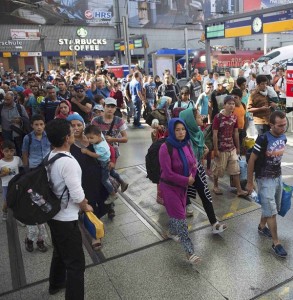Long-term bonds a solution to migration crisis?
It’s obvious that Europe, not just Sweden, needs a sustainable plan for at least the next five years.
Europe hopefully headlined its summit in Malta on migration as “international” while knowing that it bears most of the responsibility.
This has happened by default. Europe did not provoke the rush of migrants. It cannot end the Syrian war and weak authoritarian governance in Eritrea that is driving people to leave their homes. It can either watch people die as they follow the trail that leads from the Mediterranean to the rich north or it can look after them and process asylum claims.
The issue may be international but immediate action has become a test of European-ness — of its heart, moral fibre, ability to unite in adversity and efficiently execute some sort of plan.
With some slip-ups and backsliding, this is coming to pass.
Spain said on November 5th it rescued 517 people adrift in a boat off Libya. The Greek Coast Guard reported more than 370 people were saved in operations near Kos and Lesbos. In a sign that the asylum process may now be better resourced, especially in high-demand countries such as Germany and Austria, a steady monthly rise in applications is reported.
The European Union as a whole also appears to be increasingly resigned to the inevitability of the situation. In the European Commission’s latest report on the future of the economy, it predicted that an additional 3 million asylum-seekers could arrive on Europe’s shores by the end of 2016.
Interestingly, it said that the European Union’s overall population would rise by just a fraction — 0.4% — as a result of the influx and it forecast a small overall economic boost because of higher government spending and a bigger pool of available labour.
And yet there is no denying the problems that soar up ahead like Alpine peaks. According to the UN refugee agency, by the end of October more than 760,000 people had entered Europe in search of sanctuary or jobs.
The unremitting flow has strained the resources of even Europe’s rich north. Sweden, which has taken the largest per capita share of refugees of any EU country, said it needs emergency aid. Its bills are multiplying as it runs out of government accommodations for refugees and contracts with expensive theme parks and ski resorts in the short-term.
A good example is High Chaparral, a Wild West theme park in rural southern Sweden where 400 Syrians will get to try horseback adventures for $30 per head per night during the off-season that lasts until May.
What happens after that? It’s obvious that Europe, not just Sweden, needs a sustainable plan for at least the next five years.
Cue George Soros, the Hungarian-born hedge fund manager and liberal philanthropist, who has put forward a rather interesting, if controversial, idea.
Soros, whose Open Society Foundations consistently argues for migration and asylum policies “grounded in economic and demographic realities, not driven by temporary political considerations or popular misconceptions”, says that European countries need to find it appealing to accept refugees.
Absolutely right. There have to be incentives beyond the good public relations that comes from appearing to be compassionate.
Soros recommends that the European Union provide 15,000 euros ($16,100) per asylum-seeker to each accepting country for each of the first two years to help cover housing, health care and education costs.
His second big idea is for the European Union to raise this money “by issuing long-term bonds using its largely untapped AAA borrowing capacity, which will have the added benefit of providing a justified fiscal stimulus to the European economy”.
As a supremely canny investor — Soros is one of the world’s 30 richest people — his idea has a straightforward and unbeatable financial logic.
Chances are that long-term refugee bonds would be supported across the Arab world and beyond, a model of sustainable burden-sharing in the global village.


